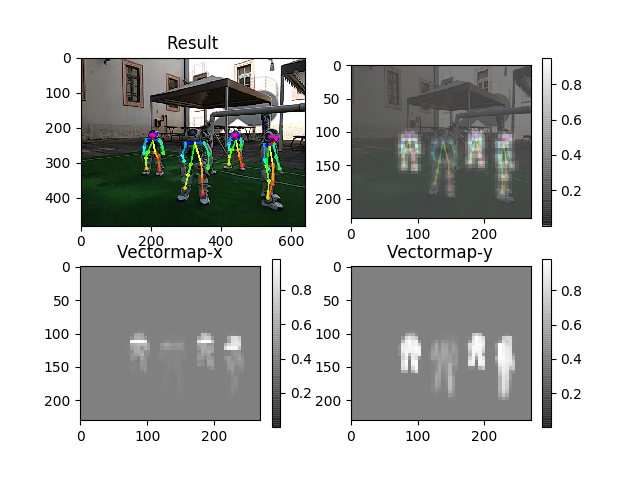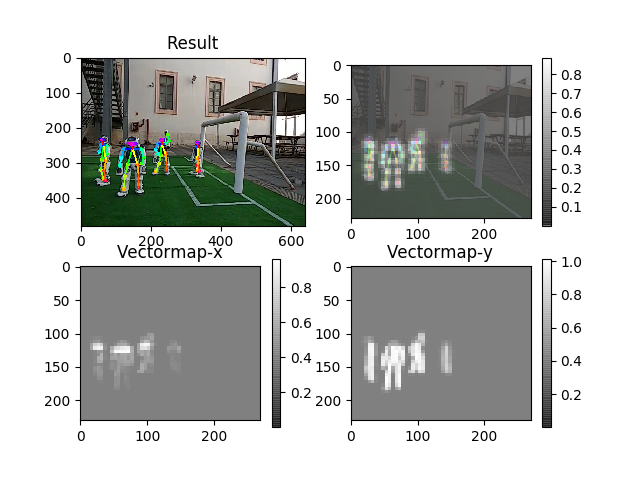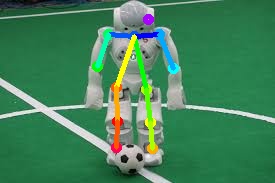Default Config |
CUDA (+Python) |
CPU (+Python) |
OpenCL (+Python) |
Debug |
Unity |
|
|---|---|---|---|---|---|---|
Linux |
||||||
MacOS |
Non-verbal communication is often used by soccer players during matches to exchange information with teammates. Among the possible forms of gesture-based interaction, hand signals are the most used. In this paper, we present a deep learning method for real-time recognition of robot to robot hand signals exchanged during a soccer game. A library for estimating body, face, hands, and foot position has been trained using simulated data and tested on real images. Quantitative experiments carried out on a NAO V6 robot demonstrate the effectiveness of the proposed approach. Source code and data used in this work are made publicly available for the community.
'Openpose', human pose estimation algorithm, have been implemented using Tensorflow. It also provides several variants that have some changes to the network structure for real-time processing on the CPU or low-power embedded devices.
To install the code you have to download the TF-Pose or Open-Pose library at this link :
- https://github.com/ildoonet/tf-pose-estimation
- https://github.com/CMU-Perceptual-Computing-Lab/openpose
You need dependencies below.
- python3
- tensorflow 1.4.1+
- opencv3, protobuf, python3-tk
- slidingwindow
Clone the repo and install 3rd-party libraries.
$ git clone https://www.github.com/ildoonet/tf-pose-estimation
$ cd tf-pose-estimation
$ pip3 install -r requirements.txtBuild c++ library for post processing. See : https://github.com/ildoonet/tf-pose-estimation/tree/master/tf_pose/pafprocess
$ cd tf_pose/pafprocess
$ swig -python -c++ pafprocess.i && python3 setup.py build_ext --inplace
Alternatively, you can install this repo as a shared package using pip.
$ git clone https://www.github.com/ildoonet/tf-pose-estimation
$ cd tf-openpose
$ python setup.py install # Or, `pip install -e .`Before running demo, you should download graph files. You can deploy this graph on your mobile or other platforms.
- cmu (trained in 656x368)
- mobilenet_thin (trained in 432x368)
- mobilenet_v2_large (trained in 432x368)
- mobilenet_v2_small (trained in 432x368)
$ cd models/graph/cmu
$ bash download.sh
You can test the inference feature with a single image.
$ python TF-Pose_NAO.py --image=./PathToImage/image.jpg
The image flag MUST be relative to the src folder with no "~", i.e:
--image ../../Desktop
Then you will see the screen as below with pafmap, heatmap and result.



http://www.dis.uniroma1.it/~labrococo/?q=node/459
[1] https://github.com/CMU-Perceptual-Computing-Lab/openpose
[2] Training Codes : https://github.com/ZheC/Realtime_Multi-Person_Pose_Estimation
[3] Custom Caffe by Openpose : https://github.com/CMU-Perceptual-Computing-Lab/caffe_train
[4] Keras Openpose : https://github.com/michalfaber/keras_Realtime_Multi-Person_Pose_Estimation
[5] Keras Openpose2 : https://github.com/kevinlin311tw/keras-openpose-reproduce
[1] https://github.com/ildoonet/tf-pose-estimation
[1] Freeze graph : https://github.com/tensorflow/tensorflow/blob/master/tensorflow/python/tools/freeze_graph.py
[2] Optimize graph : https://codelabs.developers.google.com/codelabs/tensorflow-for-poets-2
[3] Calculate FLOPs : https://stackoverflow.com/questions/45085938/tensorflow-is-there-a-way-to-measure-flops-for-a-model

